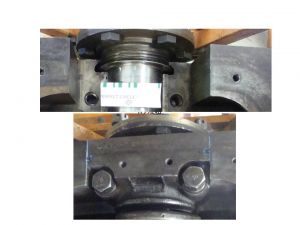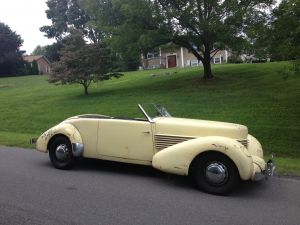- Home
- About Us
- Join/Renew
- Member Benefits
- Member Pages
- Log In
- Help
- Museum Store
Hi
I have a leak coming out of the rear “seal”” area of the engine. I have been told that there is no seal but a packing that can be tightened. Before I take the pan off I wanted to make sure that this is true?
Thanks
Joe”
Joe, I imagine the guys with more knowledge are recovering from the PAS meet, so until then here is a picture of my ’35 845 rear main when checking clearance and with the main bearing cap installed. The rear seal is simply a “slinger” without a mechanical seal or packing. It relies on centrifugal force to keep the oil from coming out. If put on a steep enough incline with the engine stopped it will leak out the back. There is nothing to wear out or repack or tighten.
Some drips are to be expected, but if it is more than that I would suspect the rear cap side seals. You will note mine are very small rectangular slots. The guys at NAPA found a Ford side seal that fits this. The gasket rebuild kit I got from Olsen had .458′ x .440″ rectangular wood sticks that are much bigger than the slots on my ’35. The kit is for ’29-38 Pierce 8’s, so I am guessing earlier 8’s had larger side seals on the rear main made of wood.
Another possibility wcould be the threaded plug that plugs the back of the oil gallery adjacent to the starter.
Good luck, Jim

Jim
The setup looks very similar to a Model A main cap. They are prone to leaking when there is too much main bearing clearance. Not sure if the Pierce has the same problem when the Babbitt is excessively worn.
Joe,
Some people say that if a Pierce-Arrow is not leaking oil, or some other liquid, then there is no oil in the pan or in the other fluid reservoirs.
That said, my Series 80 does not leak oil, that is, until I drive it or trailer it and then the jostling of the oil while in transit leaks out of the rear of the engine / transmission.
It bugs me, but I just clean up the floor of the trailer and shrug.
Also, I went to a local sheet metal shop and had them make up a few drip pans.
I have one under the differential (I sealed the heck out of it, but I still get an occasional drip at the flange and the filling hole) and one pan that is large enough to give coverage between the transmission and rear of the engine oil pan.
I also have one that sits under the radiator because the hose clamps loosen during winter storage.
Peter
Speaking of leaks, I love Pierce Arrows of course, but by chance also own an unrestored 1937 Cord standard phaeton. Was at the ACD Festival a few years back, and after the parade through town, two other 810/812 Cords parked next to my ratty one, as my friend and I had just taken a seat. They were both beautiful, brand new, restorations, and they were both leaking water (overheating). I turned to my friend and said “uh oh, my car must be out of coolant, it’s not leaking!” (it runs cool!)…he laughed, but one of the owners overheard me and the look he gave me wasn’t as pleasant as it could have been!

David,
I guess that they are too snooty to take a joke!
Peter
Pierce Arrows are like Jaguars. They’re not leaking, they’re simply marking their territory.
Joe, yes loose clearances an/or the drain partially plugged with gunk could cause excessive leakage from the main. I guess it is mainly a question of how bad the leak is and is it worth chasing.
In terms of “marking territory”, my Packard has a Bijur system that lubricates the spring shackles and intentionally drips at every shackle. Years ago a friend with a restoration shop was sued by a finicky owner who claimed negligence because his early ’30’s Packard leaked on his pristine garage floor. Despite calling an expert who went through the whole system to the judge to explain they were supposed to drip by design he lost the case. A comment on the intelligence of our judiciary.
Jim
I’ve always heard about the old DC-3 airplanes that, if a pilot was pre-flighting and an engine WASN’T leaking oil, he’d refuse to fly it….in the old radial engines usually no leak meant no oil….
Just thought I would mention that, in general, excessive crankcase pressure can cause increased leaking.
That said, some drip is normal. I also have drip pans. Flower shops sometimes have thin plastic pans to catch drips under flowers when they are watered; also used cafeteria trays at the local flea market make great pans.
David, I love the look of your Cord.
To find one unmolested has got to be a rare feat.
Randy,
I love the cafeteria tray concept!
I think that I need to steal a few from the local high school.
Peter
I stayed a little closer to home and “borrowed”” a few of my wife’s older jelly roll pans out of the cupboard. 
James”
I was shocked at the local parts house asking $39 plus tax for a tin drip pan, so I started considering alternatives.
Thanks everybody for your advice. It leaks quite a bit. I will get it up on the rack in the next couple of days and see what is happening.
Joe
My thanks to, I don’t know what I would do without PAS web site. It has been invaluable over the last 16 years restoring my 1247 . The post at the top about the rear seal being a Salinger with no modern seal or packing was reassuring . I can remember Eric Rosenau and Bill Lawron telling me that it was only a Salinger with no seal ten years ago when I rebuilt the V12. Until now I’ve had a hard time believing that and worried that I may have misunderstood. Doug Vogel
